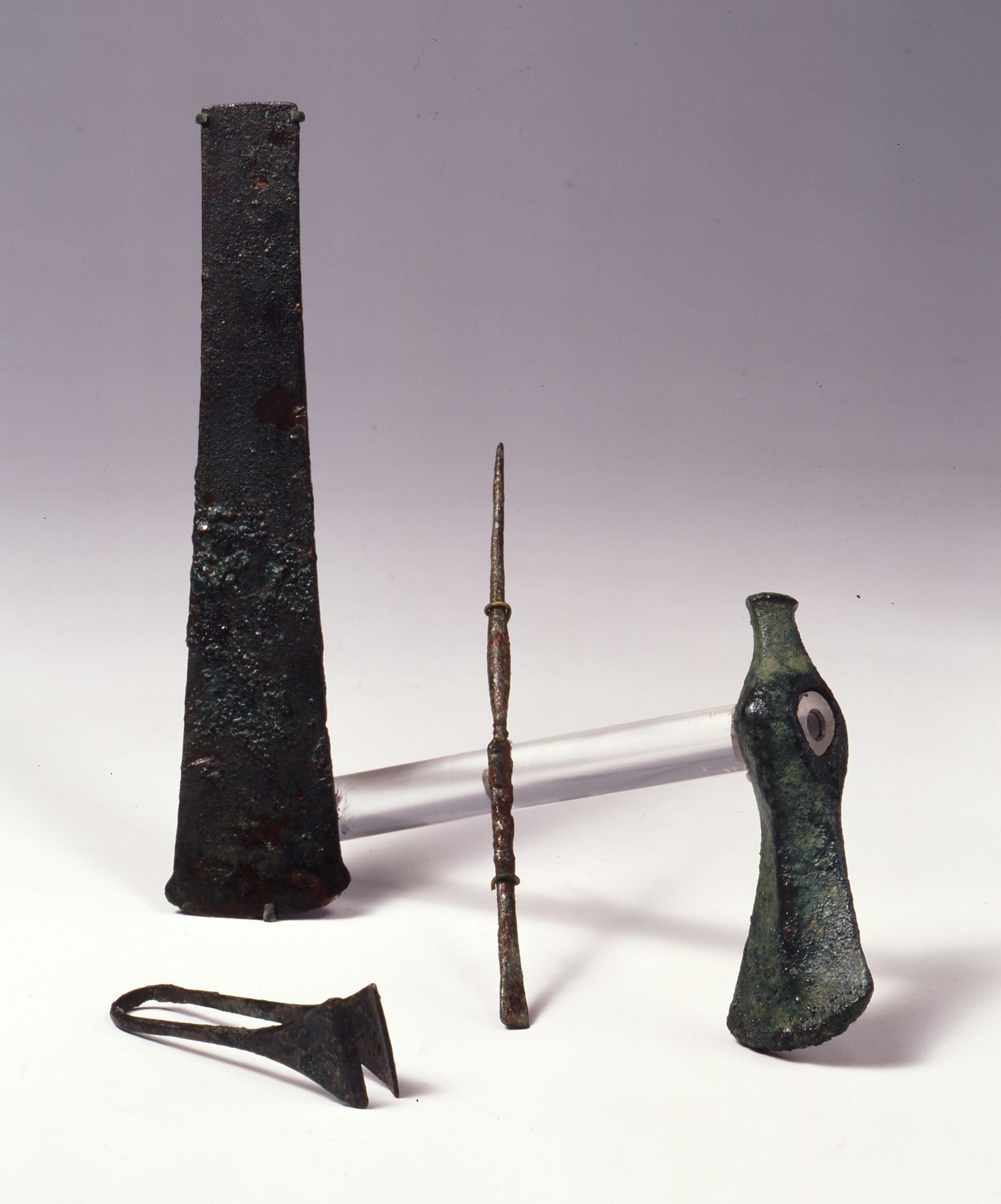Tools of the Cycladic Culture
CYCLADIC CULTURE

TYPES OF TOOLS
A piece of this heavy and dense stone–which is commonly found on Naxos–can be easily turned into a mallet (for shaping the figure) simply by making its edge pointed or sharp.
Emery was also probably used for drills (to carve and pierce specific anatomical details such as the eye, ear, navel, and loin cavities, or repair holes), for engraving tools (for incised details), or even for surface polishing, since emery powder was an effective abrasive for the initial working of the marble.
Obsidian–widely available on Melos–and flint may have also been employed in marble carving. When shaped into blades (or flakes, which were created by striking a flint or obsidian core with another stone at a specific angle to break off an incredibly sharp and thin blade), these materials could be used as engraving tools or for reducing the smoothness of a marble surface. Then, in the final stage, Theran pumice soaked in water was an excellent material for polishing the surface of the sculpture. Sand mixed with water also worked well for this step.
Regarding metal tools, bronze chisels were often used in stone carving and carpentry, but they also might have been used for working with other materials. However, their poor durability (due to the high copper content), along with the high cost of metals during the period, probably made metal stone-working tools less practical and, therefore, less common.
STAGES OF FIGURINE MANUFACTURE
As we can deduce from the few unfinished figurines that have been discovered so far, the first step of the sculpting process was to roughly shape the raw piece of marble into a figure by striking it with a mallet. Then, emery powder was used to wear away the surface until it obtained the desired shape and size. Once this was achieved, the surface was carefully smoothed before the craftsman began the delicate work of carving the details.
In the end, the figurine was polished to a degree that is still considered incredible by modern standards. Evidence of horizontal, vertical or diagonal smoothing is often visible on the surface of marble figurines and, sometimes, we can see the marks left by the tools used to level the contours of the leg cleft on “canonical” figurines. Traces of repairs are also discernible in some examples.
“ARTISTS” OF FIGURINES
The creation of a Cycladic figurine was accomplished with reference to a strict set of rules and a detailed system of proportions, which required precise measurements and considerable skill to apply. Therefore, it was most likely the work of specialized craftsmen, who probably passed on their knowledge to younger artisans only after the latter had spent a significant period of time working as their apprentice. Some scholars have attempted to identify individual “artists” or workshops by distinguishing groups of figurines with similar characteristics. Those “artists” (or workshops) have been traditionally named after the museum or the city which hosts characteristic works by them, after the excavator who brought them to light, or after the collector who possesses them (e.g. the Berlin Master, the Doumas Master, the Goulandris Master, etc.).
Other scholars, however, reject these attributions as misleading, and believe that any perceived similarities are the result of chronological or geographical proximity. We should keep in mind that the available evidence for the techniques employed in Cycladic marble-carving is very fragmentary, and that our knowledge stems almost exclusively from careful observations of the figurines themselves. The archaeological evidence from the marble workshop found in the so-called “Building of the Figurines” in the settlement of Skarkos on Ios island, which helps us understand the organization of the production of marble figurines, is particularly important in this regard.
COPPER PROCESSING
Direct evidence of bronze-working in the Cyclades is limited but telling. Archaeologists have found the remains of hearths and crucibles from the Early Cycladic III period at Kastri on Syros, alongside pieces of slag (which are created when hot or molten metal lands on the ground and cools in the soil) and stone moulds. These pieces of evidence show that metal smiths knew how to cast bronze and produced both cast and hammered objects. Metallurgical workshops, a large number of copper objects, as well as residues of metal processing came to light at the settlement of Dhaskalio. The spread of metallurgy in the Aegean during the third millennium BC inspired crafts such as building, shipbuilding, carpentry, and the minor arts. At the same time, it promoted trade and contributed to the development of social stratification (i.e., hierarchy).
Mainly, however, it brought about significant advancements in warfare tactics. Bronze weapons became relatively common in the Cyclades in the later stages of the Early Cycladic II period, which seems to be related to the social disturbances and upheavals that archaeologists have observed in the Aegean during the transition into the Early Cycladic III period. According to one theory, this turmoil was due to conflicts between local populations over access to raw materials, such as copper, or access to networks trafficking metals that were more difficult to obtain, such as tin.



